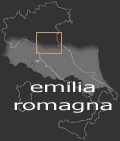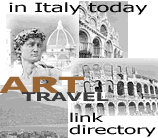|
|
 This is a file from the Wikimedia
Commons. Click the pic to see its description page and licensing.
This is a file from the Wikimedia
Commons. Click the pic to see its description page and licensing.
PARMA
Parma, Capital
for more than three centuries of an important Duchy, has preserved
numerous memories of its noble past in: the splendid artistic
monuments which can be found in various museums, in its very
lively cultural traditions (the University of Parma is one
of the oldest in Italy, the local newspaper The Gazzetta di
Parma, is the oldest Italian newspaper (1735), musically (the
City, seat of Conservatory A. Boito and the Institute of Veridani
Studies). It also owes its fame as a great musical centre
to the excellent operatic competency of the passionate visitors
at the renowned Regio Theatre).
A central habitation existed during the Bronze Age, but the
true and proper communal structure presumably dates back to
the Etruscans (6th Century) who were succeeded by the Galli
Boi (4th Century BC) and finally by the Romans over the course
of it being conquered by the Gallia Cisalpina (end of 3rd-beginning
of 2nd Century BC). The Romans then made it into a colony
(183 BC) and from that moment saw the beginning of fortune
for the City. It obtained Roman citizenship in 49 BC. Even
through the decline of the Empire, it conserved its prestigious
position thanks to the Episcopal seat, probably instituted
during the first half of the 4th Century. During Ostrogoth
domination, the City suffered great damage in the Gothic-
Byzantine war. Then from the second half of the 6th Century,
the Byzantine administration favoured the City by establishing
in it the seat of the State Treasury (giving it the name of
Chrysopolis (“City of Gold”), often attributed
to it in the medieval era). Through being conquered by the
Longobards (569), Parma became the seat of a Duke and with
the Franca conquest (774), of a Count. The ties with both
the Episcopate and the Empire put Parma, during the feuds
between the Empire and the Papacy around the second half of
the 11th Century; in contrast with the latter. The City and
the Episcopate passed from the Imperial side to the Papal
side after being conquered by Countess Matilde di Canossa
(1104). Initially, the Commune Citizenship (1085-1090) was
formed. In the conflict between the Communes and Federico
I Barbarossa, after having supported the Emperor, it became
an ally of the Lega Lombarda (Lombard League (1167). During
the feuds between Federico II and the Lombard Communes, the
City sided with the Emperor, who granted it huge favours;
but due to internal divisions by opposing factions, for the
upper hand of the Guelphs, Parma, led by Bernardo Rossi, finally
rebelled against the Ghibellines. Attacked and besieged by
Federico II, the City saw a memorable victory over him (February
1248) and one which was determinant regarding the fate of
Sveva power in Italy. In the second half of the 13th Century,
with the upper hand of the Guelphs and populate (represented
by the artisans and merchants organised in corporations, as
well as the Society of Crusaders) against the nobility, the
upper classes were profiled. These upper classes were affirmed
with the Da Correggio, who resisted in the City both by contrasts
and expulsions until the beginning of the 16th Century. Afterwards,
the upper classes of the Visconti family (1346-1404 and 1420-1447)
returned a certain tranquillity of the City and encouraged
economic progress by inserting it into the powerful political
system of Milan. That same political position was carried
on by the Sforza family (1449-1500), but grave turbulence
intervened in the first half of the 16th Century when the
City, during the Wars of Predominance, suffered domination
alternatively by the French and the Papacy. In 1545 Pope Paul
III Farnese (who was bishop of Piacenza) excluded Parma from
the dominions of the Church and made it, together with Piacenza,
into a Duchy to benefit his son Pier Luigi; whose dynasty
lasted until the end of 1731. The Farnese family increased
the honour of the City during the Renaissance period to great
artistic and cultural splendour. The Farnese family were succeeded
by the dynasty of the Bourbon family (except for a brief period
of Absburgica domination from 1738-1748) under which Parma
became a more active centre through illuministic thinking
and through reformist activity on the peninsula.
|
|
|
 This is a file from the Wikimedia
Commons. Click the pic to see its description page and licensing.
This is a file from the Wikimedia
Commons. Click the pic to see its description page and licensing.




